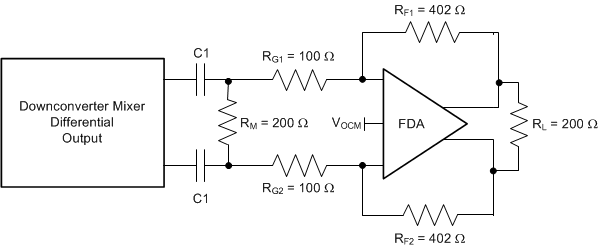ZHCSH86B December 2017 – February 2019 LMH5401-SP
PRODUCTION DATA.
- 1 特性
- 2 应用
- 3 说明
- 4 修订历史记录
- 5 说明 (续)
- 6 Pin Configuration and Functions
- 7 Specifications
-
8 Parameter Measurement Information
- 8.1 Output Reference Nodes and Gain Nomenclature
- 8.2 ATE Testing and DC Measurements
- 8.3 Frequency Response
- 8.4 S-Parameters
- 8.5 Frequency Response with Capacitive Load
- 8.6 Distortion
- 8.7 Noise Figure
- 8.8 Pulse Response, Slew Rate, and Overdrive Recovery
- 8.9 Power Down
- 8.10 VCM Frequency Response
- 8.11 Test Schematics
- 9 Detailed Description
-
10Application and Implementation
- 10.1 Application Information
- 10.2
Typical Application
- 10.2.1 Design Requirements
- 10.2.2 Detailed Design Procedure
- 10.2.3 Application Curves
- 10.3 Do's and Don'ts
- 11Power Supply Recommendations
- 12Layout
- 13器件和文档支持
- 14机械、封装和可订购信息
9.3.3.1 AC-Coupled, Differential-Input to Differential-Output Design Issues
When using the LMH5401-SP with an ac-coupled differential source, the input can be coupled in through two blocking capacitors. An optional input differential termination resistor (RM) can be included to allow the input RG resistors to be scaled up while still delivering lower differential input impedance to the source. In Figure 60, the RG elements sum to show a 200-Ω differential impedance and the RM element combines in parallel to give a net 100-Ω, ac, differential impedance to the source. Again, the design proceeds ideally by selecting the RF element values, then the RG to set the differential gain, then an RM element (if needed) to achieve a target input impedance. Alternatively, the RM element can be eliminated, the RG elements set to the desired input impedance, and RF set to the get the differential gain (= RF / RG). The dc biasing in Figure 60 is very simple. The output VOCM is set by the input control voltage and, because there is no dc current path for the output common-mode voltage, that dc bias also sets the input pins common-mode operating points.
 Figure 60. Downconverting Mixer AC-Coupled to the LMH5401-SP (GV = 4 V/V)
Figure 60. Downconverting Mixer AC-Coupled to the LMH5401-SP (GV = 4 V/V)